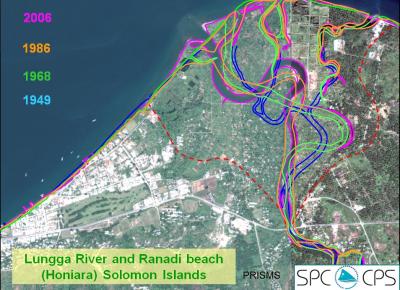
22 August 2013 - Secretariat of the Pacific Community - Suva, Fiji - Better preparing communities for cyclones, floods, droughts, and predicted sea level rise is a top priority for many Pacific island nations. The urgency to prepare however, does not justify cutting corners.
Climate change adaptation planning should follow the same national processes as any development, with environmental impact assessments, technical surveys, and cost benefit analyses.
This was the argument Dr. Arthur Webb of the Secretariat of the Pacific Community’s Applied Geo Science and Technology Division (SOPAC) presented to a diverse audience of students, academics and development practitioners at USP Marine Science Campus on Thursday 17th August.
“Nine out of ten communities want a sea wall,” said Dr. Webb, an expert in coastal processes, “but putting concrete over a healthy beach system is an example of maladaptation. It will do more harm than good. Not only will it disrupt the flow of sediments, in many cases increasing erosion, but it’s terrible for tourism.”
Webb displayed examples of maladaptation that had been carried out in the Pacific. In one instance, mangroves were planted on an atoll coastline where they were not naturally occurring.
The planting of mangroves is often seen to be a harmless ‘soft solution’ to provide coastal protection, but in this case, the mangroves, as an introduced species, were displacing other native tree species.
Webb also showed a series of images of the Lungga River delta just outside Honiara, the capital of the Solomon Islands, demonstrating the changing shape of the river over more than 80 years.
“This is an extremely dynamic and flood-prone environment,” Webb explained, indicating that the river delta: “is not a good place to encourage development and settlement, with or without climate change. Anyone who moves into this area is going to be vulnerable to erosion and inundation.”
“Adaptation isn’t just about building sea walls, it’s about improved planning in the way we allow our urban centres to expand,” argued Webb. “If we start to move into climate change adaptation without dealing with existing development issues as well, we will pay for it in the long run.”
Webb pointed out that the climate change funding coming into the region presents a major opportunity. “But is it, for example, sensible to invest millions to build a sea wall to protect a storm ridge that historically, has always been unstable and moved?” Webb asked the audience. “Our communities have limited resources and we must use what resources are available for long-term adaptation options, not quick fixes.”
Alternatively, Webb suggested options such as moving hospitals, schools, and utilities away from the coastline and building homes in frequently flooded areas on stilts. According to Webb, there is no silver bullet solution that works for every community, in every location thus reinforcing the importance of site-specific technical assessments and planning.
Dr Webb was invited to speak at USP as part of the Pacific Centre for Environment and Sustainable Development (PACE-SD) speaker series.
ENDS
For more information, contact Molly Powers-Tora (Tel.: +679 3249 250 ext. 35278 ; email:
This e-mail address is being protected from spambots. You need JavaScript enabled to view it
